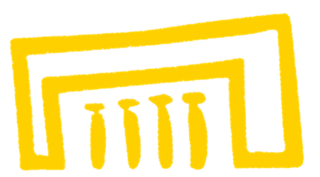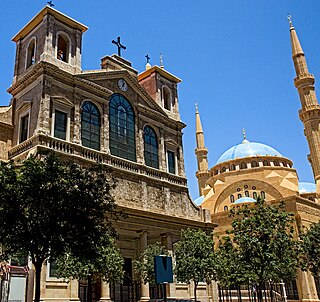
The culture of Lebanon and the Lebanese people emerged from various civilizations over thousands of years. It was home to the Phoenicians and was subsequently conquered and occupied by the Assyrians, the Greeks, the Romans, the Persians, the Arabs, the Crusaders, the Ottoman Turks and the French. This variety is reflected in Lebanon's diverse population, composed of different religious groups, and features in the country's festivals, literature, artifacts, cuisine and architecture of Lebanon. Tourism in Lebanon is popular with periods of interruption during conflict.

The Beirut Central District is the historical and geographical core of Beirut, the capital of Lebanon. Also called downtown Beirut, it has been described the “vibrant financial, commercial, and administrative hub of the country.” It is thousands of years old, traditionally a focus of business, finance, culture and leisure.

The National Museum of Damascus is a museum in the heart of Damascus, Syria. As the country's national museum as well as its largest, this museum covers the entire range of Syrian history over a span of over 11 millennia. It displays various important artifacts, relics and major finds most notably from Mari, Ebla and Ugarit, three of Syria's most important ancient archaeological sites. Established in 1919, during King Faisal's Arab Kingdom of Syria, the museum is the oldest cultural heritage institution in Syria.

The National Museum of Beirut is the principal museum of archaeology in Lebanon. The collection begun after World War I, and the museum was officially opened in 1942. The museum has collections totaling about 100,000 objects, most of which are antiquities and medieval finds from excavations undertaken by the Directorate General of Antiquities.

The Department of the Middle East, numbering some 330,000 works, forms a significant part of the collections of the British Museum, and the world's largest collection of Mesopotamian antiquities outside Iraq. The collections represent the civilisations of the ancient Near East and its adjacent areas.
Nedim Kufi, born 1962 in Baghdad), is an Iraqi-Dutch multi disciplinary visual artist. He is primarily known for conceptual art that explores themes such as war, political conflict, exile, loss, and historical memory. Much of his work contains autobiographical elements. He is also a graphic designer and print maker.

The tourism industry in Lebanon has been important to the local economy historically and to this day comprises a major source of revenue for the country.

The Temple of Eshmun is an ancient place of worship dedicated to Eshmun, the Phoenician god of healing. It is located near the Awali river, 2 kilometres (1.2 mi) northeast of Sidon in southwestern Lebanon. The site was occupied from the 7th century BC to the 8th century AD, suggesting an integrated relationship with the nearby city of Sidon. Although originally constructed by Sidonian king Eshmunazar II in the Achaemenid era to celebrate the city's recovered wealth and stature, the temple complex was greatly expanded by Bodashtart, Yatonmilk and later monarchs. Because the continued expansion spanned many centuries of alternating independence and foreign hegemony, the sanctuary features a wealth of different architectural and decorative styles and influences.
Jaber Alwan is an Italian artist and painter of Iraqi descent.

Mathaf: Arab Museum of Modern Art in Doha, Qatar, offers an Arab perspective on modern and contemporary art and supports creativity, promotes dialogue and inspires new ideas. The museum boasts a collection of over 9,000 objects and also presents temporary exhibitions, library, and a robust educational program. Established in 2010, it is considered to be among the most important cultural attractions in the country.

The Archaeology Museum of the American University of Beirut in Beirut, Lebanon is the third oldest museum in the Near East after Cairo and Constantinople.

Dia Al-Azzawi is an Iraqi painter and sculptor, now living and working in London, and one of the pioneers of modern Arab art. He is noted for incorporating Arabic script into his paintings. Active in the arts community, he founded the Iraqi art group known as New Vision and has been an inspiration to a generation of young, calligraffiti artists.

Mahmoud Obaidi is an Iraqi-Canadian artist whose work has been exhibited in museums and galleries around the world.
The Hurufiyya movement (Arabic: حروفية ḥurufiyyah, adjectival form ḥurufī, 'letters' is an aesthetic movement that emerged in the second half of the twentieth century amongst Muslim artists, who used their understanding of traditional Islamic calligraphy within the precepts of modern art. By combining tradition and modernity, these artists worked towards developing a culture specific visual language, which instilled a sense of national identity in their respective nation states, at a time when many of these states where shaking off colonial rule and asserting their independence. They adopted the same name as the Hurufi, an approach of Sufism which emerged in the late 14th–early 15th century. Art historian Sandra Dagher has described Hurufiyya as the most important movement to emerge in Arabic art in the 20th century.
Rafa al-Nasiri was an Iraqi painter, draughtsman, print-maker, educator and author whose works with a social and political message resonated with the Iraqi public in the mid-20th century. He was also very influential in encouraging young artists to take up print-making.
Amer al-Obaidi is an Iraqi-born painter, now residing in the United States, who is noted for artwork that emphasises Iraqi folklore and tradition.
Ali Talib is an Iraqi painter, noted for his abstract works and for curating exhibitions featuring Iraqi artists.

Dimitri Constantine Baramki, often styled D. C. Baramki, was a Palestinian archaeologist who served as chief archaeologist at the Department of Antiquities of the Government of Mandatory Palestine from 1938 to 1948. From 1952 until his retirement, he was the curator of the Archaeological Museum at the American University of Beirut, Lebanon, where he served as a professor of archaeology.

Barjeel Art Foundation is a non-profit arts organisation based in Sharjah, United Arab Emirates. The foundation was established in 2010 by Emirati commentator Sultan Sooud Al Qassemi to manage and exhibit his personal art collection. There are over 1,000 pieces of modern and contemporary art in the foundation's art collection. The organisation primarily focuses on artwork produced by Arab artists worldwide and includes paintings, sculptures and installations.


















